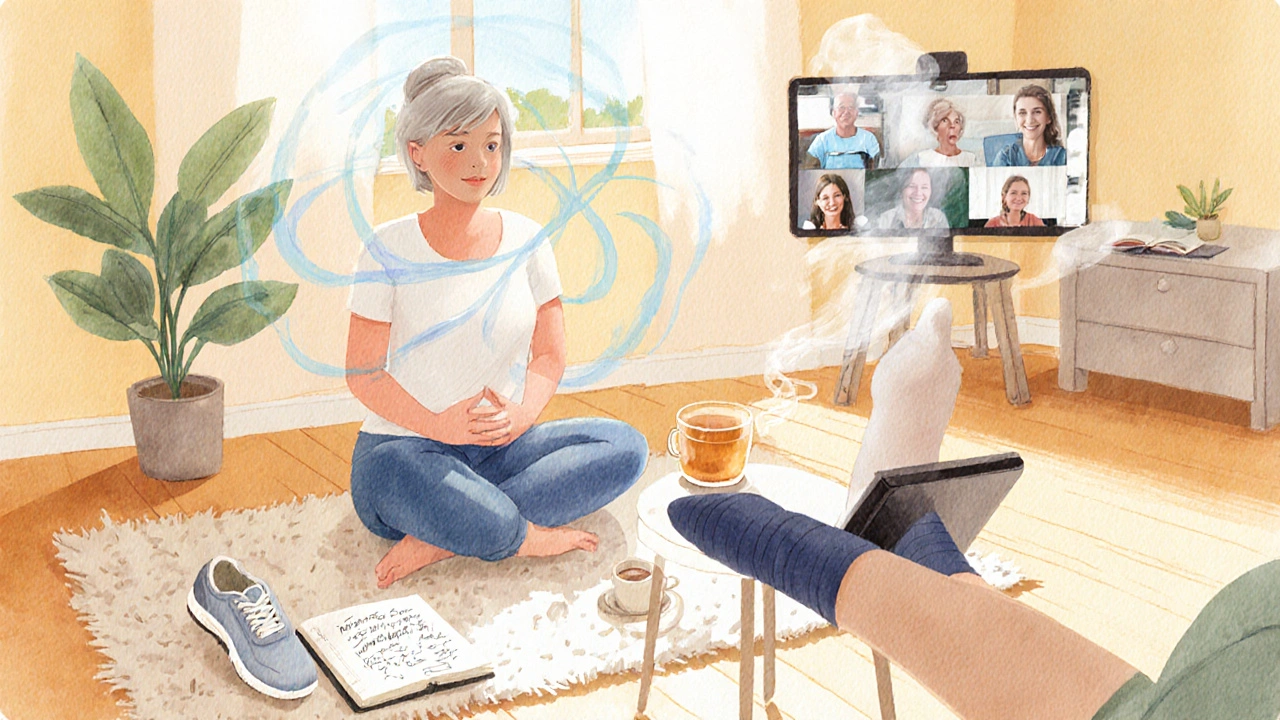
DVT Psychological Impact Assessment
Receiving a DVT diagnosis can trigger various emotional reactions. This tool helps you recognize common psychological impacts and learn effective coping strategies.
Anxiety
Persistent worry, heart-racing, difficulty sleeping.
Typical onset: Hours to daysDepression
Low mood, loss of interest, fatigue.
Typical onset: Weeks after diagnosisHealth-Related PTSD
Flashbacks, avoidance of medical care, hyper-vigilance.
Typical onset: Months, especially after complicationsCoping Strategies
- Ask for a Simple Explanation: Request that your provider describe the clot, its location, and the treatment plan in plain language.
- Schedule a Mental-Health Check: Many vascular clinics screen for anxiety or depression during the first visit.
- Use Mind-Body Techniques: Guided breathing, progressive muscle relaxation, or mindfulness apps help lower short-term anxiety.
- Stay Physically Active Within Limits: Light walking, ankle pumps, and compression stockings improve circulation and boost mood.
- Connect with Others: Join a patient support group online or in-person to share experiences and encouragement.
- Track Your Thoughts: Journaling about fears helps identify patterns and reframe irrational beliefs.
- Limit Over-Research: Pick reputable sources like the American Heart Association to avoid health anxiety.
Healthcare Provider Best Practices
- Deliver the diagnosis in a private, calm setting.
- Use lay terms and check for understanding.
- Offer written summaries covering both medical and emotional coping tips.
- Screen for anxiety, depression, and PTSD using tools like GAD-7 or PHQ-9.
- Refer patients to mental-health professionals when needed.
- Schedule a follow-up call within a week to address lingering worries.
Resources for Support
- National Blood Clot Alliance (NBCA): Printable guides, webinars, and moderated forums.
- American Psychological Association (APA) – Find a Therapist: Search by specialty in health anxiety or chronic illness coping.
- Local Hospital Social Work Departments: Free counseling sessions for recent diagnoses.
- Mobile Apps: “Calm” and “Headspace” offer modules for medical anxiety.
- Physical Therapy Clinics: Safe, clot-friendly activity plans to keep you moving.
When to Seek Immediate Help
- Sudden shortness of breath, chest pain, or coughing up blood—possible pulmonary embolism.
- Severe, unrelenting anxiety leading to panic attacks and inability to function.
- Thoughts of self-harm or hopelessness—contact a crisis line immediately.
Quick medical attention prevents physical complications and opens doors for urgent mental-health support.
Receiving a diagnosis of deep vein thrombosis can feel like the ground just dropped out from under you. Beyond the physical risks, the news often triggers a storm of thoughts, fears, and emotions that linger long after the clot is treated.
Key Takeaways
- Emotional reactions to a DVT diagnosis are common and can include anxiety, depression, and health‑related PTSD.
- Factors such as personal medical history, support networks, and how information is delivered shape the psychological impact.
- Early screening for mental distress and timely referrals to mental‑health professionals improve outcomes.
- Practical coping tools-mindfulness, activity modification, and patient support groups-help restore confidence.
- Healthcare providers play a crucial role by delivering clear explanations and integrating mental‑health care into treatment plans.
What is Deep Vein Thrombosis?
When doctors confirm deep vein thrombosis is a blood clot forming in the deep veins, typically in the legs, that can obstruct blood flow and pose serious health risks, the immediate concern is physical-preventing the clot from traveling to the lungs and causing a pulmonary embolism. However, the diagnosis also introduces a psychological dimension that many patients overlook.
Typical Emotional Reactions
Most patients report an instant surge of fear. The word “clot” conjures thoughts of heart attacks and sudden death, even though the medical reality differs. This fear often morphs into anxiety, characterized by racing thoughts about future health, work ability, and family responsibilities.
In parallel, feelings of loss of control emerge. Suddenly, a routine activity like a long flight or a day at the office feels risky. Such loss can trigger depressive moods, where motivation dips, sleep patterns shift, and the future appears bleak.
For some, especially those with prior traumatic medical experiences, the DVT diagnosis can ignite symptoms reminiscent of post‑traumatic stress disorder (PTSD). Flashbacks of hospital stays, hyper‑vigilance about physical sensations, and avoidance of medical settings are not uncommon.

Key Psychological Conditions Linked to DVT
Below is a quick snapshot of the most frequently observed mental‑health outcomes after a DVT diagnosis.
| Condition | Core Symptoms | Typical Onset | Impact on Treatment Adherence |
|---|---|---|---|
| Anxiety | Persistent worry, heart‑racing, difficulty sleeping | Hours to days after diagnosis | May lead to missed medication doses |
| Depression | Low mood, loss of interest, fatigue | Weeks after diagnosis | Reduces motivation for follow‑up appointments |
| Health‑Related PTSD | Flashbacks, avoidance of medical care, hyper‑vigilance | Months, especially after a severe complication | Can cause complete disengagement from care |
What Influences the Psychological Impact?
Not every patient reacts the same way. Several factors shape how intense the emotional response becomes.
- Previous Health Experiences: Individuals who have endured prior serious illnesses often have a heightened sense of vulnerability.
- Risk Factor Awareness: Knowing that immobility, recent surgery, or genetic clotting disorders increase DVT risk can either empower patients (through control) or amplify fear.
- Support System Quality: A strong network of family, friends, or online forums buffers stress, while isolation magnifies it.
- Information Delivery: Clear, compassionate communication from clinicians reduces uncertainty. Jargon‑heavy explanations tend to increase anxiety.
- Socio‑Economic Context: Access to medication, ability to take time off work, and insurance coverage affect both physical and mental health outcomes.
Tools and Strategies to Manage the Emotional Fallout
Below are practical steps that patients can adopt right after hearing the diagnosis.
- Ask for a Simple Explanation: Request that the provider describe the clot, its location, and the treatment plan in plain language. Understanding the "why" behind anticoagulant therapy (anticoagulant therapy medications that thin the blood to prevent clot growth and new clots) reduces the unknown.
- Schedule a Mental‑Health Check: Many vascular clinics now embed a brief screening for anxiety or depression during the first visit. If you’re flagged, ask for a referral to a psychologist or psychiatrist.
- Use Mind‑Body Techniques: Guided breathing, progressive muscle relaxation, or short mindfulness apps have been shown to lower short‑term anxiety scores in DVT patients.
- Stay Physically Active Within Limits: Light walking, ankle pumps, and prescribed compression stockings improve circulation and boost mood. Consult your physiotherapist for a safe regimen.
- Connect with Others: Join a patient support group online or in‑person community where members share experiences, coping tricks, and encouragement. Hearing stories of successful recovery can replace catastrophic thinking.
- Track Your Thoughts: Journaling about fears-especially health‑related anxiety-helps you identify patterns, challenge irrational beliefs, and gradually reframe them.
- Limit Over‑Research: While information is empowering, endless Googling can fuel health anxiety. Pick reputable sources like the American Heart Association or your physician’s handouts.

The Role of Healthcare Providers
Doctors, nurses, and pharmacists aren’t just there to prescribe a venous ultrasound imaging test that visualizes clots in deep veins or dispense blood thinners. They also act as first‑line mental‑health allies.
Best practices include:
- Delivering the diagnosis in a private, calm setting.
- Using lay terms and checking for understanding.
- Offering written summaries that cover both medical and emotional coping tips.
- Screening for anxiety, depression, and PTSD using brief tools like GAD‑7 or PHQ‑9.
- Referring patients to mental‑health professionals when scores are moderate or higher.
- Scheduling a follow‑up call within a week to address lingering worries.
When clinicians acknowledge the emotional weight of a DVT diagnosis, patients report higher satisfaction and better adherence to anticoagulant regimens.
Resources You Can Turn To Right Now
Here’s a quick checklist of places you can find reliable help.
- National Blood Clot Alliance (NBCA): Offers printable guides, webinars, and a moderated forum for patients.
- American Psychological Association (APA) - Find a Therapist: Search by specialty in health anxiety or chronic illness coping.
- Local Hospital Social Work Departments: Many provide free counseling sessions for recent diagnoses.
- Mobile Apps: “Calm” and “Headspace” have specific modules for medical anxiety.
- Physical Therapy Clinics: Can design safe, clot‑friendly activity plans to keep you moving.
When to Seek Immediate Help
If you notice any of the following, contact your care team or emergency services right away:
- Sudden shortness of breath, chest pain, or coughing up blood-possible pulmonary embolism.
- Severe, unrelenting anxiety that leads to panic attacks and inability to function.
- Thoughts of self‑harm or hopelessness-reach out to a crisis line immediately.
Quick medical attention not only prevents physical complications but also opens the door for urgent mental‑health support.
Frequently Asked Questions
Can a DVT diagnosis cause long‑term depression?
Yes, especially if the clot leads to lifestyle restrictions or recurrent medical scares. Studies show about 20% of DVT patients develop depressive symptoms that persist beyond six months unless they receive counseling or medication.
Is it normal to feel panic after a venous ultrasound?
Feeling a spike of panic is common because the test highlights the clot’s size and location. Knowing the results can actually reduce anxiety, so ask the technician to explain what they see in simple terms.
How soon should I talk to a therapist after diagnosis?
Ideally within the first two weeks. Early intervention helps prevent the escalation of anxiety or depressive thoughts and supports better medication adherence.
Do support groups really help?
Yes. Peer groups provide validation, practical tips, and a sense of community. A 2023 survey of 800 DVT survivors found that participants in support groups reported 30% lower anxiety scores.
Can lifestyle changes reduce the chance of future clots?
Absolutely. Regular low‑impact exercise, maintaining a healthy weight, staying hydrated, and using compression stockings when advised all lower recurrence risk, which in turn eases mental stress.
16 Comments
Ogah John
October 7, 2025 At 16:33Oh great, another medical pamphlet telling us how to feel about a clot, because we clearly needed a philosophy lecture on anxiety.
Kelvin Murigi
October 8, 2025 At 08:06First off, kudos to the authors for covering the mental‑health side of DVT – that’s often the missing piece in clinical talk.
When you get the diagnosis, the brain goes into overdrive, scanning every past ache for hidden clots.
That hyper‑vigilance can be a double‑edged sword: it keeps you alert, but it also fuels anxiety loops.
One practical move is to set a daily “check‑in” time, say 5 p.m., where you review your medication schedule and jot down any worries.
Writing those thoughts down anchors them to paper rather than letting them swirl forever.
Another evidence‑based tool is paced breathing: inhale for four counts, hold for four, exhale for six – repeat for two minutes when panic spikes.
Studies show that regulated breathing dampens the amygdala’s alarm response, which is exactly what you need after a clot scare.
If you have access to a therapist, ask for a brief CBT session focusing on health‑related catastrophizing; those techniques reframe “What if the clot travels?” into “I’m taking X, Y, Z, and my doctor monitors me.”
Don’t forget physical activity within safe limits – even a 10‑minute ankle pump routine every hour can improve venous return and release endorphins, upping mood naturally.
Compression stockings, while sometimes uncomfortable, provide tactile reassurance that blood isn’t pooling, which can be soothing for those with phantom sensations.
On the digital front, pick one reputable app – Calm, Headspace, or Insight Timer – and stick with a single guided module; hopping between apps breeds information overload.
Limit Googling to official sites like the American Heart Association; the internet is a black hole for health anxiety and can turn a reasonable concern into a horror story.
Peer support is another gold mine: online forums moderated by clinicians weed out misinformation, and hearing survivors share their timelines normalizes the emotional rollercoaster.
When you feel the mood dip into depression, schedule a brief “joyful activity” – a favorite song, a quick walk, or a call with a friend – to counteract the brain’s default to rumination.
Lastly, keep your follow‑up appointments; the act of checking in with your doctor reinforces that you’re not alone in this journey, and documented progress charts can be a morale booster.
All of these steps together create a comprehensive safety net that addresses both clot prevention and the psychological fallout that often follows a DVT diagnosis.
ahmad matt
October 8, 2025 At 23:40Look, I’m not here to sugarcoat anything – you get a clot and suddenly every random ache feels like a ticking time‑bomb you’re too stupid to defuse.
kristine ayroso
October 9, 2025 At 15:13Yo dude, stop moanin’ and actually do the ankle pumps! If you cant even follow a simple exericise routine, you’re just askin for more trouble – get moving already!
Ben Small
October 10, 2025 At 06:46Listen up, you’ve got this – treat the clot like a boss level in a video game. Each day you take your meds, do the walks, and track your thoughts is another point earned. Keep grinding and you’ll beat the anxiety raid.
Dylan Hilton
October 10, 2025 At 22:20Just a friendly reminder to double‑check your spelling when you write down symptoms – a typo can lead to a mis‑interpretation and unnecessary panic. Keep it clear!
Christian Andrabado
October 11, 2025 At 13:53Wow, another sad story about a clot. Feel the pain, drink some water, move on.
Chidi Anslem
October 12, 2025 At 05:26The emotional impact of a DVT is often underappreciated, yet cultural perceptions of illness can shape how patients seek support and internalise their experience.
Holly Hayes
October 12, 2025 At 21:00Honestly u shouldnt be so dramatic about every little ache its just a clot dont make a mountain out of a molehill.
Penn Shade
October 13, 2025 At 12:33Everyone keeps spouting generic advice while the real issue is that most clinicians forget to screen for PTSD after a clot event, leading to chronic avoidance behaviours.
Jennifer Banash
October 14, 2025 At 04:06While the above contributions are appreciated, I must emphasize the importance of maintaining a decorous tone when discussing health anxieties; using melodramatic language undermines the gravity of the situation.
Stephen Gachie
October 14, 2025 At 19:40One might argue that the very act of prescribing a formal, measured discourse imposes a veneer of control over the inherently chaotic experience of illness; nevertheless, the patient still navigates an existential labyrinth where each step is both a literal and metaphorical anticoagulant.
Sara Spitzer
October 15, 2025 At 11:13Sure, the guide is nice, but let’s be real – most of these “support groups” are just a bunch of people whining about the same thing, and they waste your time.
Jennifer Pavlik
October 16, 2025 At 02:46Hey, I get that it can feel repetitive, but sharing stories can actually help people feel less alone. If you try listening, you might find a tip that actually works for you.
Jacob Miller
October 16, 2025 At 18:20Honestly, if you don’t follow the simple steps listed, you’re just asking for more problems – it’s not rocket science.
Anshul Gandhi
October 17, 2025 At 09:53What they don’t tell you is that the pharmaceutical industry pushes anticoagulants to keep you dependent, while the real cure is staying away from the medical establishment that’s complicit in mass surveillance of our health data.

Post A Comment